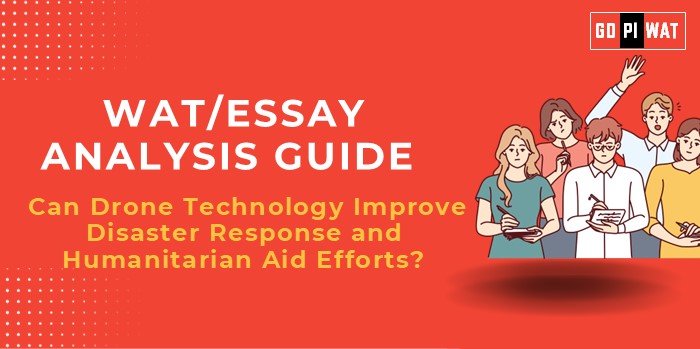📋 Written Ability Test (WAT)/Essay Analysis Guide: Can Drone Technology Improve Disaster Response and Humanitarian Aid Efforts?
🌐 Understanding the Topic’s Importance
Drones bridge the gap between timely aid and inaccessible disaster zones, offering unparalleled advantages. Their increasing adoption reflects their potential in saving lives during humanitarian crises.
⏱️ Effective Planning and Writing
- Time Allocation:
- 📖 Reading & Planning: 5 minutes
- ✍️ Writing: 20 minutes
- 🔍 Review: 5 minutes
- Preparation Tips:
- 🌍 Research global success stories like Turkey-Syria earthquake response.
- ⚖️ Familiarize yourself with challenges like cost and regulation.
✒️ Introduction Techniques for Essays
- 📊 Contrast Approach: “While helicopters remain the standard for disaster response, drones offer faster and more cost-effective solutions in reaching remote areas.”
- 🔑 Solution-Based Approach: “Drones address critical disaster response gaps, providing real-time mapping and swift aid delivery, essential for saving lives.”
📚 Structuring the Essay Body
- Achievements:
- Highlight successful drone deployments in disaster zones, such as real-time mapping during the Turkey-Syria earthquake.
- Showcase examples like Bangladesh’s flood aid or Rwanda’s medical supply delivery.
- Challenges:
- Discuss high costs limiting widespread adoption, especially in low-income regions.
- Address privacy concerns and regulatory barriers that complicate drone usage.
- Future Outlook:
- Propose advancements like AI integration for predictive disaster management.
- Recommend innovations in affordable drone manufacturing to enhance accessibility.
📄 Concluding Effectively
- ⚖️ Balanced Perspective: “While drones enhance disaster response, their effectiveness hinges on overcoming regulatory and ethical challenges.”
- 🌍 Global Comparison Approach: “Countries like Japan and Rwanda exemplify the transformative potential of drones in disaster management.”
📊 Analyzing Successes and Shortcomings
- Key Achievements: Faster response times, cost-efficient mapping, and improved aid delivery.
- Ongoing Challenges: Legal hurdles, privacy concerns, and cost barriers.
- Global Context: Benchmarking against Japan’s advanced disaster response systems and Rwanda’s success in medical supply delivery.
🌱 Recommendations for Sustainable Progress
- 🤝 Encourage public-private partnerships to reduce costs and improve technology access.
- ⚖️ Develop robust legal frameworks to address privacy and ethical concerns in drone use.
- 🎓 Train disaster response teams in drone operations to maximize efficiency and effectiveness.
📝 Sample Short Essays
- ⚖️ Balanced Perspective: “Drones have redefined disaster response, offering unparalleled advantages in speed and efficiency. However, their potential is constrained by high costs and regulatory challenges. Global collaboration is essential to address these issues.”
- 🔑 Solution-Oriented: “By integrating drones into disaster response, we can revolutionize aid delivery. Overcoming cost barriers through partnerships and addressing privacy concerns through regulations will unlock their full potential.”
- 🌍 Global Comparison: “Countries like Rwanda demonstrate how drones can efficiently deliver aid in remote areas. By emulating such models, disaster-prone regions can enhance resilience and reduce response times.”
Note: This guide equips candidates to write impactful essays by integrating real-world examples and proposing balanced, actionable solutions.


